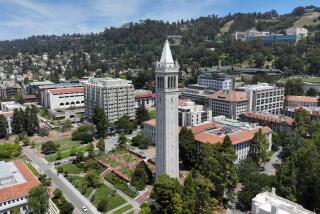Confusion Over UC Transfers Continues
- Share via
The state reversed itself last week and said it would give 5,800 recent high school graduates the option of heading directly to University of California campuses without first attending community college. But many of those students are learning that they won’t be admitted to their top-choice UC schools.
The system’s three most selective campuses -- UC Berkeley, UCLA and UC San Diego -- had originally offered several thousand students a “guaranteed transfer option,” but just fewer than 740 of them accepted and agreed to complete two years of community college studies before enrolling in UC. Now those 740 won’t have to fulfill that requirement and can go directly to one of those three campuses.
On the other hand, students who previously turned down transfer deals from UC Berkeley, UCLA and UC San Diego won’t get new offers to attend those campuses. These students will be referred instead to one of the five less-selective UC undergraduate campuses.
The latest news fuels the confusion that has surrounded the now-aborted transfer program since Gov. Arnold Schwarzenegger’s administration proposed it in January as a cost-cutting measure.
The state budget agreement last week provided extra money that UC said would help it enroll 1,600 more students. That’s the number that officials estimated would take the admissions offers so late in the game. But UC said it would enroll more if there was additional demand among the affected students.
In some cases, students still don’t know whether they will be offered admission for the fall, winter or spring terms. In the case of UC Berkeley, UCLA and UC San Diego, none of the new students will be able to begin until winter or spring.
Also, requirements for how students spend their time between now and when they enroll are being decided on a campus-by-campus basis. UC Berkeley, for instance, is requiring that the new students take at least 12 units of community college courses this fall.
“For students and family members, it’s been tough, given the roller coaster” of events, said Mae W. Brown, director of admissions at UC San Diego. Still, she said, “we’ve certainly done the very best we could do given the budget considerations, and we’re delighted that this finally has been resolved.”
Hanan Eisenman, a UC spokesman, said the decision by UC Berkeley, UCLA and UC San Diego to refer students to other campuses was due to shortages of faculty, facilities and preparation time.
Eisenman said many of the students who had rejected the transfer offer “probably did so because they had another four-year-college option. While we are disappointed they may not choose to come to UC, they probably found a college option that was a good fit for them.”
Availability of campus housing remains a question for some new arrivals, as do their chances of getting all the courses they want.
The five less-selective campuses -- UC Davis, UC Santa Cruz, UC Santa Barbara, UC Irvine and UC Riverside -- will be able to enroll students who had accepted their own two-year transfer plans as well as the students referred from UC Berkeley, UCLA and UC San Diego.
However, the students who previously turned down guaranteed transfer options to the five less-selective campuses face uncertainties; they too may get their admission offers from a school that isn’t their first choice, or that is different from the campus that offered them a transfer deal previously.
The admissions maneuvers are being lamented as another unfortunate twist.
“It seems to me that it’d only be fair to have a system in place that treats all of these students, whether they accepted the redirection program or not, equally,” said state Assembly Speaker Fabian Nunez (D-Los Angeles), who helped craft the budget agreement to provide more enrollment funds for the UC and California State University systems. “The way it was explained to me was that all of these students would be treated the same.”
Nunez said he did not want to criticize UC leaders, who he said were trying to make the best of a difficult situation. The speaker said that he would “take up” the issue with UC leaders but that he had no intention of trying to push them to change their plans.
The situation for students is clearer at the 23-campus CSU system, where administrators never redirected any applicants to community colleges this spring and instead planned to make another round of enrollment cuts. Now, however, CSU officials plan to restore space for about 7,500 students, with most of the new arrivals starting in January.
For some of the affected UC aspirants, particularly those who rejected guaranteed transfer options but who are interested in attending a UC campus, it’s a nerve-racking time.
For example, Arlene Salazar of Pacoima turned down guaranteed transfer options from UC Berkeley and UC San Diego in favor of going to Mount Holyoke College in Massachusetts. But now she is having second thoughts about being so far from her family.
Like other students, Salazar was notified over the last week that she would receive a new UC offer for the fall, winter or spring term, but she doesn’t know which campus it will be from. If it came soon from UC Irvine or UC Davis, Salazar said, she probably would accept.
“It depends where I get it from and how soon,” she said. “I’ve been checking the mail every day. I’m just really in the middle; I really don’t know.”
But Doris Leung of Glendale, who this year missed the deadline to accept a guaranteed transfer option from UCLA and then decided to attend Cal State Long Beach, is less inclined to make a switch at this point.
“I’m basically already settled, and doing all the scheduling and stuff like that again is hectic,” she said.
Still, Leung said she was pleased to have another chance to consider a UC education and might be willing to make a change if an offer came, particularly from UC Santa Barbara.
“There’s a sense of hope, I guess, to be reaccepted” by UC, she said.
Students can get more information at a UC website: www.universityofcalifornia.edu/gto. In addition, they can send an e-mail to UC at [email protected] or call the university system at (510) 987-9528.
More to Read
Sign up for Essential California
The most important California stories and recommendations in your inbox every morning.
You may occasionally receive promotional content from the Los Angeles Times.










